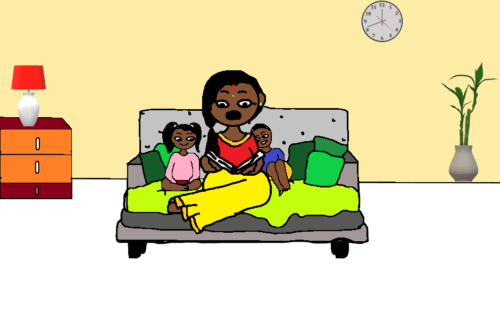In our current series we discuss text structure, that is, how authors organize information in the books they write. Last week, we looked at narrative text structure, which is how stories are organized. This week we’ll share some ideas on what you can do to develop your child’s understanding of narrative text structure.
Just to recap, the five elements of a story are the characters, settings, conflict, plots, and theme. Now, say you read a story with your child; you must draw your child’s attention to the details of these elements. How do you do that? You ask questions or model how you think aloud about the story. You do these
1. Before you read the book,
2. During the read-aloud and
3. After reading the book.
Let’s pick a familiar fairy tale for your read-aloud, The little red riding hood, and see how you do this.
Before you begin to read the book:
How do you start a read-aloud? If you said by reading the book’s title, you’re right. You begin with the book cover and read the title first. “The Little Red Riding Hood. Mmm…this is a fairy tale. Do you know what a fairy tale is?” This question connects the story to something the child knows because most children have read fairy tales. It is a prompt to think about common elements of a fairy tale.
Draw your child’s attention to the images on the cover by asking, “Why do you think the book is called Little Red Riding Hood.” Your child will probably point to the little girl with the red cape.
“Yes, I see a little girl in a red cape. I wonder if the story is about her. Who else is here on the cover?” Now, pause and wait for your child to answer.
Then say, “That’s right! There’s a wolf. What do you think the story is about?” Pause for your child to make a prediction.
“Oh, you think the story is about a little girl and a wolf? I think so too. Where are they?”
Your child may answer, forest or woods, or jungle.
Validate their answer, “Yes, it looks like it happens in a forest.”
What is the reason for these questions and comments? You have got your child thinking about the characters and the setting right from the get-go. Did you notice that I paused after my questions? That’s because I’m waiting for the child to answer. Be patient. Let your child do the thinking while you learn to wait for them to process and respond.
What do you do during the read aloud:
As you read the story, introduce more questions or comments about the characters, settings, problem, and resolution—questions that do not have yes or no answers. When you involve them in looking for information in the book, children become active participants. They’ll develop opinions, ideas, likes, and dislikes about the events in the book. They are not going to say, “My teacher didn’t teach me that!”
Here are some questions or comments for you to introduce to your child as you read the story:
Make personal connections: When you come to the part where red riding hood talk to the wolf, ask your child, “What should red riding hood do when she sees the wolf? What should you do if a stranger approaches you?”
Explore Red Riding Hood’s character a little more:
“Why do you think she talked to the wolf?”
“How does Red riding hood feel when she meets the wolf?” If your child cannot answer that one, that’s okay. Point to the expression on her face and describe how she looks. “Look at her eyes….” Your child gathers information from the illustrations.
Make predictions: “Why is the wolf hurrying to granny’s house?”or, “Look, the wolf is wearing granny’s glasses and cap and lying in Granny’s bed! Why? What do you think will happen next?”
Now you’re heading to the climax of the story. You’ve got your child thinking about the problem and how the story will end.
In these instances, you prompt your child to make a prediction based on what he already knows. There is no right or wrong answer. So, accept whatever your child says.“Oh, you think so! Let’s keep reading and see if you are right!”
What are some questions you can ask after reading the book?
Monitoring or keeping track of understanding: Remind your child about the prediction towards the end of the story. “Remember you said the wolf was going to frighten grandma…Did that really happen?” Here, you teach them to check their own prediction to see if it came true or something else happened.
Ask more questions that connect all the details after reading the story, like the following:
“Have you ever talked to strangers? What did you do?“
“The wolf’s disguise fooled little Red Riding Hood. How did the wolf disguise himself? Would that disguise fool you?“
“Do you think this could be an actual story, or is it make-believe? How do you know?“
“Wolves cannot talk; you cannot cut open the wolf and get the whole person out. What kind of a story cannot happen in real life? You are right; it is called fiction!”
“What did you like best about the story? Why?” You may get the strangest opinions on why they like the story, but that is okay because children are learning to form their opinions about the book.
Also ask, “What surprised you in the book? Why”
Do you notice how easily you can guide your child to think critically about the story? If you want to challenge your child further, get alternative versions of the Little Red riding hood and compare them to the traditional tale.





